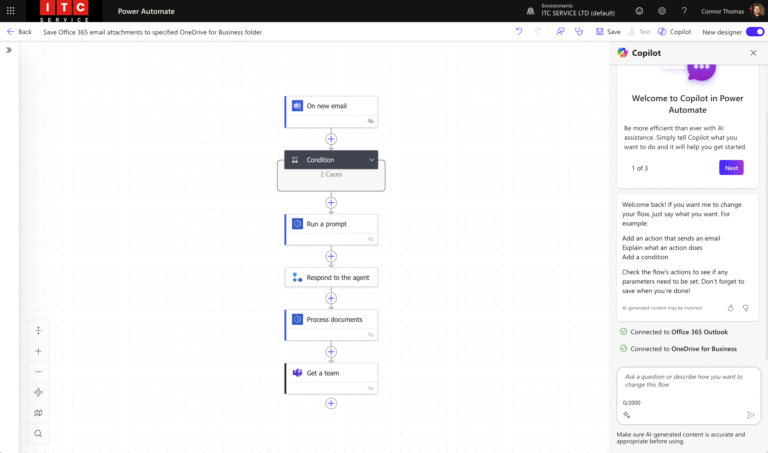What is Proactive Monitoring.
Proactive monitoring is the ongoing observation of systems, applications, or infrastructure to detect issues before they cause significant problems for your businesses. Whether it be downtime or severe performance degradation.
Proactive monitoring considers all the different aspects of managing IT infrastructure; from hardware, software, networking and even global issues. Utilising an advanced suite of tools, proactive monitoring engineers are often the unsung heroes of IT. Without them, it’s likely your business will suffer from far more technological challenges.
In addition to detecting issues, engaging in proactive monitoring of your infrastructure empowers you to make strategic IT decisions for your business. For instance, you can determine the optimal timing to release patches or updates so that downtime is minimised. Or upgrade components at the right time to accommodate an uptick in user activity. By leveraging the information you collect proactively, you can minimise user disruption while also maximising the cost-effectiveness of your IT investments.
From patch management and security checks to backup continuity and network maintenance. All these measures are designed with the goal in mind of keeping systems always running smoothly while avoiding expensive emergency repairs caused by overlooked issues or outdated equipment/software configurations.

The key benefits of proactive monitoring
Taking a proactive approach to IT support has been a game-changer for many businesses. It dramatically decreases the chances of events like a simple drive failure resulting in a catastrophic loss of data. Here are some of the key advantages that come with investing in proactive IT Support services:
- Early detection of issues: By constantly monitoring IT systems, proactive monitoring can detect potential issues early, before they become major problems. This can help IT teams address issues before they impact users or cause downtime, ensuring the continued availability and reliability of critical systems.
- Improved system performance: Proactive monitoring can help IT teams identify performance bottlenecks and optimize system performance. By tracking key performance metrics, IT teams can make informed decisions about system configuration and resource allocation, improving the overall performance of IT systems.
- Reduced downtime: By identifying and addressing issues before they cause downtime, proactive monitoring can help reduce the amount of time that critical systems are unavailable. This can help businesses avoid lost revenue and reputation damage caused by system outages.
- Better security: Proactive monitoring can help IT teams detect potential security threats early, before they result in data breaches or other security incidents. By constantly tracking network activity and system logs, proactive monitoring can help IT teams identify and respond to security threats quickly and effectively.
- Cost savings: By identifying and addressing issues early, proactive monitoring can help businesses avoid costly repairs and downtime. Additionally, by optimising system performance and resource allocation, proactive monitoring can help businesses make the most of their IT investments, reducing overall costs.
Best proactive monitoring process:
Proactive monitoring / Proactive IT Support is only as good as the engineers who deploy, monitor and action it’s results. Here are some of the best proactive monitoring processes that ITC Service follow.
Deploy monitoring tools:
The first step in the proactive monitoring journey is to deploy a suite of tools that allow us to see the overall health of your devices and network. The tool collects lots of non-sensitive data about patch history, resent downtime, potential viruses and more
Identify Areas for Concern:
The proactive monitoring team will assess your infrastructure and decide whether there are elements of it that need to be improved. This could be unsafe software needing removal. Or hard drives that have early indications of failure. They will then work with you to decide the best order of priorities
Setting Up Alerts:
An engineer will also establish whether any non-standard elements of your infrastructure need to be monitored. They will then setup a series of alerts, which ensure that any problems notify the proactive monitoring team.
Automated Resolution of issues:
Many of the problems Proactive Monitoring teams experience can be resolved almost automatically. Engineers continuously strive to develop tools and processes that make resolutions fast and efficient. An example is a script to force an update of an application. Many of the automated scripts are developed on a per-business basis.
Manual Resolution of issues:
If an alert is raised and the systems can’t fix the problem automatically. It is then assigned to an engineer who will seek to resolve the issue. Potentially preventing downtime. The engineer will also consider how to prevent it from happening again in the future.
Continuous Development:
But it doesn’t end there. A strong proactive monitoring team continually seeks to monitor, prevent, and address issues to an even greater extent. Resulting in less downtime, saved costs and less headaches.
How proactive monitoring saved a large travel business
A large travel business stores thousands of customers’ data on a local server. The server is backed up properly with onsite and offsite copies meaning there is no risk of losing data.
However, the server has 2 hard drives that are showing early signs of failure. The proactive monitoring team identifies this and arranges for the drives to be replaced and the data restored out-of-hours, causing no disruption to the businesses. Had the drives failed, you would have no choice but to replace the drives within working hours at the earliest convenience and restore from the latest backup. This would have resulted in costly downtime for this travel business. This one event alone covers the cost of proactive monitoring to the business.

Using Proactive Monitoring to maintain storage availability
One of the more frequent problems seen by an IT service desk is problems caused by devices and servers hitting their file capacity limits. For example, when a windows machine reaches very little space on its primary drive, it no longer has enough available space for completing simple tasks that are essential for the function of the operating system. This causes computers to crash and render unusable in some cases. On servers, the fix for this can be expensive and time-consuming. However, if caught early, you can ensure the resources grow with the demand.
Conclusion on Proactive Monitoring for business
Proactive monitoring is a critical component of effective IT management that enables businesses to detect and address potential issues before they become major problems. By deploying a suite of monitoring tools, IT teams can gain visibility into the overall health of their infrastructure and applications and can identify areas of concern that need to be addressed. With the ability to set up alerts and automate issue resolutions, proactive monitoring can help businesses minimize downtime, improve system performance, enhance security, and reduce overall costs. As demonstrated by the example of the travel business, investing in proactive monitoring can save businesses significant amounts of time and money, while also ensuring the continued availability and reliability of critical systems. Proactive monitoring is an essential practice for any business that depends on IT to operate effectively and efficiently.
If you would like to learn more on how Proactive Monitoring and IT Support can help your business. Get in touch. We’d be more than happy to help!













